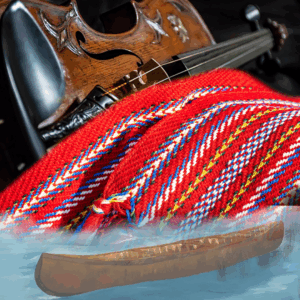Iconic symbols of Métis culture

Métis culture is immediately recognizable through its vibrant artistic expression. Some of the most iconic symbols include:
The Métis Sash
The colourful woven sash (or ceinture fléchée) is more than just a piece of clothing. Traditionally used as a belt, rope, first aid kit or tool carrier during the fur trade era, it also serves today as a symbol of unity and pride. Each sash tells a story—about region, family or community—and is worn proudly during gatherings, powwows and ceremonies.
Fiddle music and Jigging
The fiddle is the heartbeat of Métis music. A blend of European and First Nations influences, Métis fiddling is upbeat, rhythmic and often accompanied by jigging—a style of dance that combines Celtic footwork with Indigenous storytelling. Métis gatherings are incomplete without music and movement, where generations come together to celebrate through sound and step.
Beadwork and Floral Designs
Métis beadwork is often described as “the flower beadwork people.” Inspired by the beauty of nature, traditional beadwork often features vibrant floral patterns, passed down from mothers and aunties across generations. Beadwork is both art and ancestry, found on moccasins, vests, bags and even regalia worn at ceremonies and celebrations.
Michif: The Métis Language
Michif is the traditional language of the Métis people, a unique blend of Cree and French (with elements of English, Saulteaux, and other languages). It reflects the fusion at the heart of Métis identity. Though it is now considered endangered, many Métis communities are working hard to revitalize Michif, offering language classes, immersion camps and digital tools for the next generation.
Language is more than communication—it’s a carrier of worldview, memory and belonging. Revitalizing Michif is an act of cultural sovereignty and healing.



